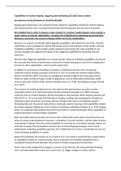Capabilities for market-shaping: triggering and facilitating increased value creation
Suvi Nenonen & Kaj Storbacka & Charlotta Windahl
Applying grounded theory, we comprehensively categorize capabilities needed for market-shaping
and synthesize them into a conceptual framework that describes the process and its outcomes.
We establish that in order to improve value creation in a market, market-shapers must consider a
larger system of relevant stakeholders, recognize the institutional arrangements governing their
behaviors, and foster new resource linkages within and across stakeholders.
Based on our analysis, we identify eight triggering capabilities, which generate new intra- and inter-
stakeholder resource linkages by directly influencing various characteristics of the market, and four
facilitating capabilities, which enable market-shaping by discovering the value potential of new
resource linkages and augment the impact of the triggering capabilities by mobilizing relevant
resources.
We show that triggering capabilities are context-specific, whereas facilitating capabilities are generic.
We conclude that there are performance outcomes of market-shaping not only for the shaping firm,
but also for other stakeholders, and at overall market level.
In addition to sensing and responding to changes in established markets, firms increasingly
undertake market-shaping strategies (Gavetti et al. 2017) to create new business opportunities
(Alvarez and Barney 2007). Literature in management provides insights into these agent-driven
efforts to shape markets through a range of approaches, such as effectuation (Sarasvathy 2008),
niche construction (Luksha 2008), market formation (Lee et al. 2018), and shaping strategy (Gavetti
et al. 2017).
Two streams of marketing literature have also explored this phenomenon: proactive market
orientation (Narver et al. 2004) and market-driving strategies (Jaworski et al. 2000). However,
empirical work on market-shaping is limited (Humphreys and Carpenter 2018), leading Jaworski and
Kohli (2017, p. 11) to conclude that Bthe idea of shaping, molding, and managing the evolution of
markets has been around for some time, but has not taken off in terms of systematic inquiry.^
Answering that call, the present study offers a systematic inquiry focusing on the capabilities needed
for market-shaping. Building on recent reviews of marketing capabilities (Morgan et al. 2018; Morgan
2012), we categorize both adaptive (Day 2011) and dynamic marketing (Morgan 2012) capabilities as
market information and knowledge capabilities
Both essentially anticipate trends and events in the market before these fully reveal themselves, by
virtue of a deep understanding of customers, competitors, channel members, and the wider business
environment. However, firms also need capabilities to act based on such market learning. Hence, we
posit that to support the formulation and execution of marketshaping strategies, and to avoid
widening the marketing capabilities gap (Day 2011; Hillebrand et al. 2015), a comprehensive view of
market-shaping capabilities is needed.
Against this backdrop, the purpose of our research is to: (1) provide a comprehensive categorization
of capabilities needed for market-shaping, and (2) synthesize the identified capabilities into a
conceptual framework that describes the process of market-shaping and its outcomes.
Hence, the market-shaping firms engage in a process to (1) discover the value potential of linking
intra- and interstakeholder resources in novel ways, (2) trigger changes in various market
, characteristics to enable the formation of new resource linkages, and (3) mobilize relevant
stakeholders to free up extant resources for new uses.
Market conceptualization:
Research in marketing and management is progressively recognizing markets as networks, systems,
or ecosystems
Value creation: linking and integrating sources:
The aim of market-shaping is to enhance the value creation and realization for stakeholders in a
market. Value creation happens when resources are combined in novel ways (Penrose 1959), the key
being the ability to create, access, deploy, combine, and exchange them
Consequently, and building on Moran and Ghoshal (1999), we view market-shaping as a purposive
process by a focal firm to (1) discover the value potential of linking intra- and inter-stakeholder
resources in novel ways, (2) trigger changes in various market characteristics to enable the formation
of new resource linkages, and (3) mobilize relevant stakeholders to free up extant resources for new
uses.
Market shaping and radical innovations
Like market-shaping, radical innovations (RI) can either transform existing markets through dramatic
behavioural changes or create new one Most radical innovations fail (Barczak et al. 2009), leading
O'Connor and Rice (2013) to conclude that firms do not seem to recognize that capabilities for
creating or transforming markets differ from those used in the earlier stages of the innovation
process. We see market creation as a special case of market-shaping as it is likely that the same
capabilities can be used. This suggests that RI success at least can and, in some cases, perhaps must
be supported by market-shaping capabilities.
Research method
Market-shaping is a complex and longitudinal process. As such, inductive methods are useful to grasp
the complexity of the market system and understand individual firms’ processes and experiences.
Following the tradition of qualitative inductive research approaches in marketing (Johnson and Sohi
2016; Gebhardt et al. 2006), we adopted grounded theory (Strauss and Corbin 1997, 1998) as our
research method. The following sub-sections describe our procedures for sampling, data collection,
and data analysis.
Sample
For us this meant finding firms from a multitude of contexts, representing a wide spread of industry,
size, country of origin, international reach, technology, strategy, ownership, and history, but sharing
one commonality: a track record of successful market-shaping.
Therefore, our sampling process consisted of four steps.
1. The first step established three criteria for what a track record of successfully engaging in
market-shaping looks like in the empirical domain
2. As a second step, we engaged six academics with research records on change in market
structures, and eight other experts (representing research institutes and consulting firms)
who had first-hand knowledge of various firms in multiple countries, in discussions to identify
firms fulfilling the defined criteria. In total 41 candidate firms were identified





